- Home
- A Brief Overview Of Puerto Rico's Nutrit...
A Brief Overview of Puerto Rico's Nutrition Assistance Program
Puerto Rico’s household food assistance program, the Nutrition Assistance Program (NAP, or PAN for its name in Spanish, Programa de Asistencia Nutricional) is one of the most important programs helping people meet basic needs in Puerto Rico. Participants receive monthly benefits on debit cards that they can use to buy food at participating stores. On average about 1.3 million people participated in NAP in 2018, about two-fifths of the Commonwealth’s population. (This brief captures the role of NAP prior to the COVID-19 pandemic.)
NAP is important given very high levels of poverty and food insecurity in Puerto Rico, which has never recovered from a recession that began in 2006, and events including two devastating hurricanes, delays in rebuilding aid, and population decline have aggravated those challenges.1 NAP’s support is limited, however, in contrast to the benefits provided under the Supplemental Nutrition Assistance Program (SNAP), the household food assistance program that operates in the 50 states, the District of Columbia, Guam, and the Virgin Islands.
How NAP Works
Eligibility for NAP is based largely on income and resources. For example, as of March 2019, a household of three must have monthly net income (income after applying certain exclusions and deductions) below $1,706 to qualify. (In recent years, income limits have been much lower, but were raised in 2018 using disaster funds after Hurricanes Irma and Maria and have since remained at those higher levels.)
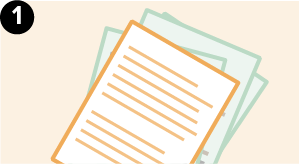
Application
To apply for NAP, a member of the household must fill out an application.
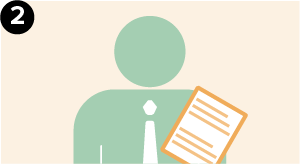
Interview
Applicants must complete an eligibility interview and present documentation to verify their information. They must also periodically re-apply.
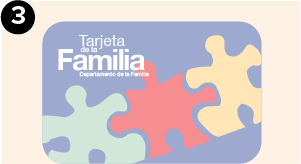
Debit card
Once found eligible, participants receive a debit card called a Family Card (Tarjeta de la Familia) that they can use at one of about 3,000 retailers in the Commonwealth, such as grocery stores.
Note: The application process is at least temporarily streamlined and modified to comply with social distancing requirements due to the COVID-19 crisis.
NAP Participation Characteristics
More than 90 percent of NAP participants had monthly income below the federal poverty line in 2018, or $20,780 per year for a family of three. Nearly two-thirds had income at or below half of the poverty line. The program has historically been targeted to households with low incomes.
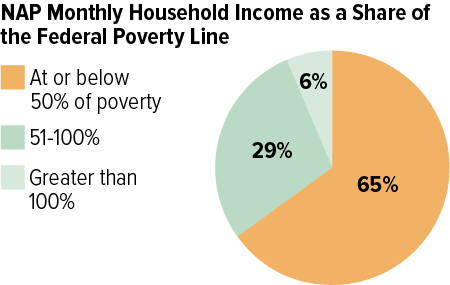
Over three-quarters of NAP participants were children, adults living with children, seniors, or people with disabilities.
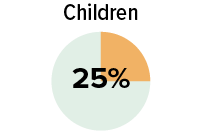 | 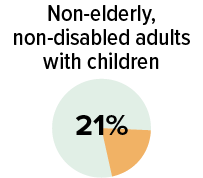 |
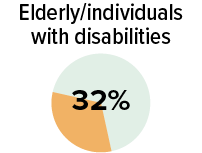 | 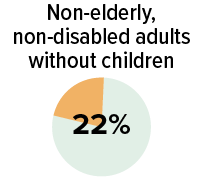 |
Gender: Over half of adult participants are women.
Education: Of adults aged 18 through 59, about 25 percent have less than a high school education, 35 percent have completed high school, and 40 percent have some post-secondary education.
Employment: Over two-thirds of non-elderly adults without disabilities are working, looking for work, or live with other household members who are working. Most of the remaining adults are studying or live with household members who are children or have disabilities.
Geography: NAP participants are distributed throughout the Commonwealth, with higher participation in areas with higher poverty rates.
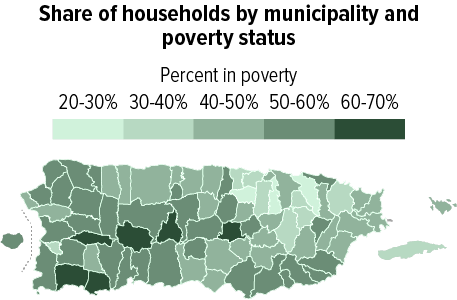
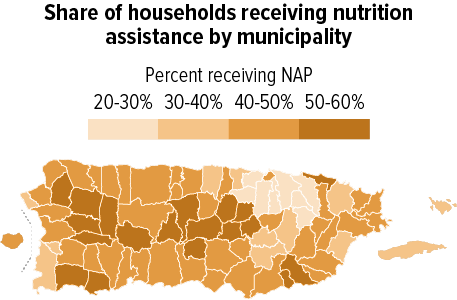
Benefits Are Modest
NAP benefits are based on household size and income. A household of three received a maximum base benefit of $315 per month in 2019, plus monthly and annual adjustments. Participants will also receive somewhat higher benefits from July 2019-July 2020 due to temporary federal disaster and emergency relief.2 Elderly individuals receive a small benefit enhancement.
Average household benefits, April 2019
All households
$223 per month
(about $122 per person)
Household with children
$356 per month
(about $110 per person)
Household with elderly individuals
$188 per month
(about $140 per person)
NAP’s Funding Structure Limits Its Effectiveness
household of three, no income
household of three, no income
Puerto Rico receives a federal block grant with a fixed amount of funding to provide NAP’s basic food assistance. The Commonwealth sets eligibility and benefit levels to keep the program’s cost within the fixed federal funding limits, which means these levels aren’t solely based on, and can’t fully respond to, need. The program is significantly less responsive than SNAP, which serves all applicants who meet the program’s eligibility criteria, which are based on poverty levels and the cost of food. As a result, if Puerto Rico participated in SNAP, eligibility and benefit levels likely would have been more generous and consistent than those in NAP in recent years.
For example, a parent of two children who loses a job and has no other income would have received the maximum monthly SNAP benefit of about $505 in the continental United States in 2019, and more in Alaska, Hawaii, Guam, and the Virgin Islands (for example, $650 in the Virgin Islands). Under regular NAP rules (not including the recent temporary disaster benefits), households of three with no income received an average of $376 in monthly NAP benefits in March through June 2019.
SNAP’s funding structure also enables it to respond to changes in demand, including those due to natural disasters or recessions, which NAP, with its limited funding, can’t.
Notes: Participant characteristics and average benefit amounts come from CBPP analysis of NAP administrative data. All participant characteristics on p. 2 are calendar year 2018 averages. In collaboration with Dr. Hector Cordero-Guzman, CBPP obtained de-identified NAP administrative data from the Puerto Rico Department of Family through a request to the Puerto Rico Institute of Statistics. For more information on NAP, see “Introduction to Puerto Rico’s Nutrition Assistance Program,” Center on Budget and Policy Priorities, January 15, 2020, https://www.cbpp.org/research/food-assistance/introduction-to-puerto-ricos-nutrition-assistance-program and Brynne Keith-Jennings and Elizabeth Wolkomir, “How Does Household Food Assistance in Puerto Rico Compare to the Rest of the United States?” Center on Budget and Policy Priorities, updated January 15, 2020, https://www.cbpp.org/research/food-assistance/how-is-food-assistance-different-in-puerto-rico-than-in-the-rest-of-the.
Map source - American Community Survey 2014-2018 5-Year Estimates
Endnotes:
1 Javier Balmaceda, “Long in Recession, Puerto Rico Needs More Than Just COVID-19 Relief to Overcome Its Crises,” CBPP, May 7, 2020, https://www.cbpp.org/research/economy/long-in-recession-puerto-rico-needs-more-than-just-covid-19-relief-to-overcome-its.
2 Puerto Rico received $600 million in nutrition assistance in July 2019 to help the Commonwealth increase nutrition assistance to deal with the ongoing economic effects from Hurricanes Irma and Maria. The Commonwealth also received additional funding from congressional relief packages to deal with costs from the COVID-19 public health and economic crisis. See Puerto Rico Federal Affairs Administration, “Governor Wanda Vázquez Garced Announces $347 million for NAP beneficiaries,” May 18, 2020, https://prfaa.pr.gov/2020/05/18/governor-wanda-vazquez-garced-announces-347-million-for-nap-beneficiaries/.